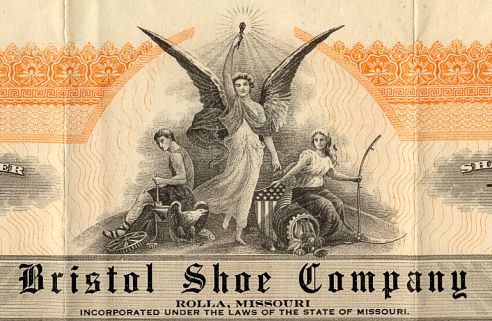Beautiful certificate from the Bristol Shoe Company issued in 1930. This historic document was printed by S.G. Adams Printers and has an ornate border around it with a vignette of a group of allegorical people. This item has the signatures of the Company's President, William Pennington and Secretary, Hazel E. Knapp and is over 78 years old. 
Certificate Vignette The Pennington-Gilbert Shoe Company was incorporated in Illinois on 24 January 1925. William Pennington of Centralia was the principal shareholder. Other stockholders and officers were Louis K. Kane, George W. Everhardt, and E. H. Grossman of St. Louis, and James B. Gilbert of Marianna, Arkansas. The company was capitalized at $200,000, later increased to $250,000, for the manufacture, buying and selling of shoes, boots, leather goods, findings, and related items. In October 1925, Pennington-Gilbert proposed to build a factory at Rolla, Missouri, if the city provided the site. Agitation for such a factory in Rolla had begun as early as 1907, and prospects looked bright in 1922 when the International Shoe Company expressed interest in building a manufacturing plant in the city. The company declined to build at Rolla in March 1923. When Pennington-Gilbert approached Rolla for a site, the city was eager to secure the factory and the prospect of several hundred jobs. The city raised money by selling lots in the new Shoe Factory Addition to Rolla, and ultimately provided a site along the railroad on the east side of the town. Construction began in November 1925, and the first shoe was cut on 24 July 1926. By February 1927, the company's one hundred employees produced five hundred pairs of women's shoes each day. By the end of the year the workforce had nearly doubled and production was over six hundred pairs of shoes daily. In 1928, the company contracted to sell its entire output to the Bristol Shoe Company, which planned to market the shoes in its own chain of sixty stores. The arrangement allowed the shoe factory to run at full production without cutbacks during dull market times. By 1930, the Bristol Shoe Company had absorbed Pennington-Gilbert, and William Pennington became the president of the Bristol Shoe Company. History from Missouri University of Science and Technology.

Certificate Vignette










